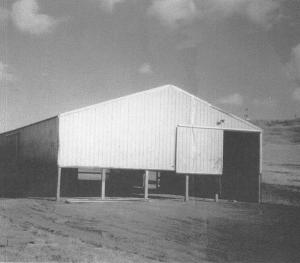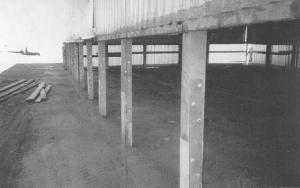He Specializes In Adding Height To Buildings
Ted Weiss of New Salem, N. Dak., operates a house and shed moving business. He recently sent FARM SHOW photos of a 45 by 80-ft. metal calf shed that he not only moved, but also raised. The building originally measured 10 ft. from the ground to the bottom of the rafters. He added 6 ft. to get a 16-ft. rafter height.
"Over time the ground under the building got so full of manure that the owner could barely get his skid loader under the rafters. With the extra height, he'll never have that problem again."
During the last five years Weiss has raised about a dozen different buildings, many of them pole sheds. "Usually, customers want higher buildings so they can store bigger machinery such as combines, air seeders and cultivators, and so forth," says Weiss.
The process of adding height to a building is usually done when the building is already securely braced for transport and is at its final location. "However, pole buildings can often be extended at their original location."
He uses a series of hydraulic jacks to raise the building. Then, it's transported on a set of wheels equipped with steerable axles.
The building shown was originally supported by 4-in. sq. wooden poles. Once the building was raised, Weiss used lag screws to attach 3-ft. long, 4-in. wide steel straps to both sides of the poles and the 6-ft. extensions he put below. Twelve lag screws were used on each pole. A series of 1/4-in. pilot holes were drilled into the wood before the metal straps were screwed on in order to limit cracking of poles.
Then, the building was braced for transport. Both channel iron and steel I-beams were used to build a grid system that allowed the building to be picked up without distorting its original shape.
At the new location, holes were drilled in the ground and the poles were lowered into them. The interior support steel was then removed. Galvanized tin was added to the lower sides of the building to close them up. The building's doors were replaced with larger ones.
"On buildings supported by round poles, I use curved steel plates instead of flat plates to attach the new and old poles together," notes Weiss.
Contact: FARM SHOW Followup, Ted Weiss, Weiss House Moving, 202 Ash Ave. East, New Salem, N. Dak. 58563 (ph 701 843-7502 or 701 220-0772).

Click here to download page story appeared in.
Click here to read entire issue
He Specializes In Adding Height To Buildings BUILDINGS New Techniques 29-4-6 Ted Weiss of New Salem, N. Dak., operates a house and shed moving business. He recently sent FARM SHOW photos of a 45 by 80-ft. metal calf shed that he not only moved, but also raised. The building originally measured 10 ft. from the ground to the bottom of the rafters. He added 6 ft. to get a 16-ft. rafter height.
"Over time the ground under the building got so full of manure that the owner could barely get his skid loader under the rafters. With the extra height, he'll never have that problem again."
During the last five years Weiss has raised about a dozen different buildings, many of them pole sheds. "Usually, customers want higher buildings so they can store bigger machinery such as combines, air seeders and cultivators, and so forth," says Weiss.
The process of adding height to a building is usually done when the building is already securely braced for transport and is at its final location. "However, pole buildings can often be extended at their original location."
He uses a series of hydraulic jacks to raise the building. Then, it's transported on a set of wheels equipped with steerable axles.
The building shown was originally supported by 4-in. sq. wooden poles. Once the building was raised, Weiss used lag screws to attach 3-ft. long, 4-in. wide steel straps to both sides of the poles and the 6-ft. extensions he put below. Twelve lag screws were used on each pole. A series of 1/4-in. pilot holes were drilled into the wood before the metal straps were screwed on in order to limit cracking of poles.
Then, the building was braced for transport. Both channel iron and steel I-beams were used to build a grid system that allowed the building to be picked up without distorting its original shape.
At the new location, holes were drilled in the ground and the poles were lowered into them. The interior support steel was then removed. Galvanized tin was added to the lower sides of the building to close them up. The building's doors were replaced with larger ones.
"On buildings supported by round poles, I use curved steel plates instead of flat plates to attach the new and old poles together," notes Weiss.
Contact: FARM SHOW Followup, Ted Weiss, Weiss House Moving, 202 Ash Ave. East, New Salem, N. Dak. 58563 (ph 701 843-7502 or 701 220-0772).
To read the rest of this story, download this issue below or click
here to register with your account number.








